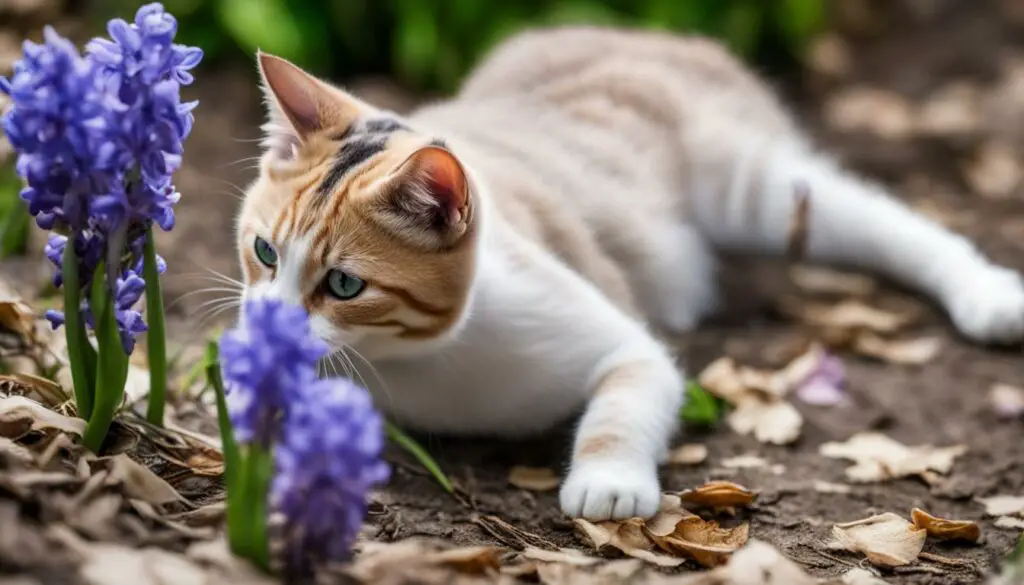Have you ever caught your furry friend nibbling on something they shouldn’t? If your cat has recently eaten a hyacinth flower, it’s important to take immediate action to ensure their health and well-being. Hyacinth bulbs contain toxins that can be harmful to cats and may lead to serious health issues. In this article, I will provide you with valuable advice and tips on how to handle this situation and keep your beloved kitty safe.
Cats are curious creatures and may be tempted to explore plants, including hyacinth flowers. These beautiful blooms, commonly found in North America, can pose a threat to your cat’s health if ingested. The toxins present in hyacinth bulbs, such as allergenic lactones, lycorine alkaloids, and calcium oxalate raphides, can cause internal or external irritation.
If your cat has consumed hyacinth, you may notice symptoms such as nausea, vomiting, diarrhea, excessive drooling, mouth irritation, depression, increased heart rate, difficulty breathing, and tremors. It’s crucial to be vigilant and take immediate action to address these signs of potential poisoning.
Key Takeaways:
- Hyacinth bulbs are toxic to cats and can cause serious health issues if ingested.
- If your cat has eaten hyacinth, look out for symptoms of poisoning such as vomiting, diarrhea, and mouth irritation.
- Contact your veterinarian immediately for guidance and treatment.
- Do not induce vomiting without professional advice.
- Prevention is key – keep potentially toxic plants out of your cat’s reach and opt for cat-safe flowers instead.
Hyacinth Toxicity in Cats
Hyacinths are beautiful flowers that can brighten up any space, but did you know that they can be toxic to cats? The bulbs of hyacinth plants contain toxins that can cause harm to our feline friends. These toxins, such as allergenic lactones, lycorine alkaloids, and calcium oxalate raphides, can irritate a cat’s mouth and digestive system, leading to serious health issues.
If your cat ingests hyacinth, they may experience various symptoms of toxicity. These can include nausea, vomiting, diarrhea, excessive drooling, mouth irritation, depression, increased heart rate, difficulty breathing, and tremors. It is important to recognize these signs and take immediate action by seeking veterinary assistance.
Remember, if your cat has consumed hyacinth or any other toxic flower, do not induce vomiting without professional advice, as it can worsen their condition. Instead, contact your veterinarian for guidance on the appropriate steps to take.
By being aware of the potential toxicity of hyacinths and other plants, we can take steps to prevent our beloved cats from coming into contact with them. Keep these flowers out of your cat’s reach, consider using hanging planters or placing them in areas that are inaccessible. There are also many cat-safe flower alternatives such as sunflowers, freesias, orchids, snapdragons, and asters that can still bring beauty into your home without posing a risk to your furry friend’s health.
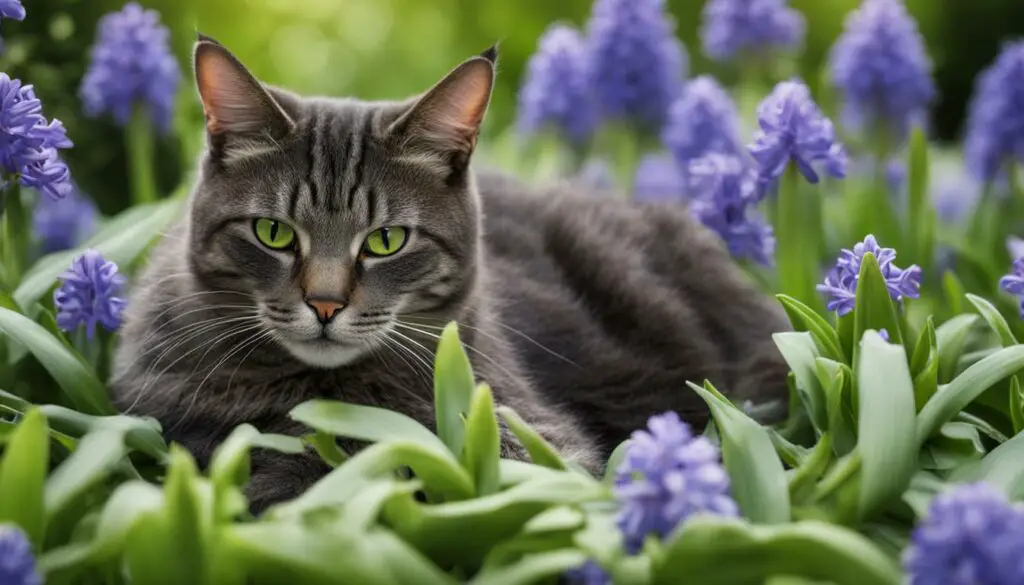
| Symptoms of Hyacinth Toxicity in Cats | Preventive Measures |
|---|---|
|
|
Remember, the well-being of our cats should always be our top priority. By taking preventive measures and being vigilant about the potential hazards of certain plants, we can ensure that our feline friends stay safe and healthy.
Signs of Cat Poisoning
If your cat has eaten hyacinth, you may notice several signs that indicate poisoning. It is important to be aware of these symptoms and take immediate action by contacting your veterinarian. Some common signs of cat poisoning include:
- Vomiting
- Diarrhea
- Excessive drooling
- Mouth irritation
- Pawing at the mouth
- Depression
- Increased heart rate
- Difficulty breathing
- Tremors
If you observe any of these indications in your cat after eating hyacinth flowers, it is crucial to seek veterinary assistance immediately. Prompt treatment can help minimize the effects of poisoning and ensure your cat’s well-being.
Signs of Cat Poisoning
Poisoning in cats can manifest in various ways. Keep a close eye on your cat’s behavior and look for these signs that may indicate hyacinth poisoning:
- Vomiting
- Diarrhea
- Excessive drooling
- Mouth irritation
- Pawing at the mouth
- Depression
- Increased heart rate
- Difficulty breathing
- Tremors
If you notice any of these symptoms, it is important to contact your veterinarian immediately for guidance and treatment.
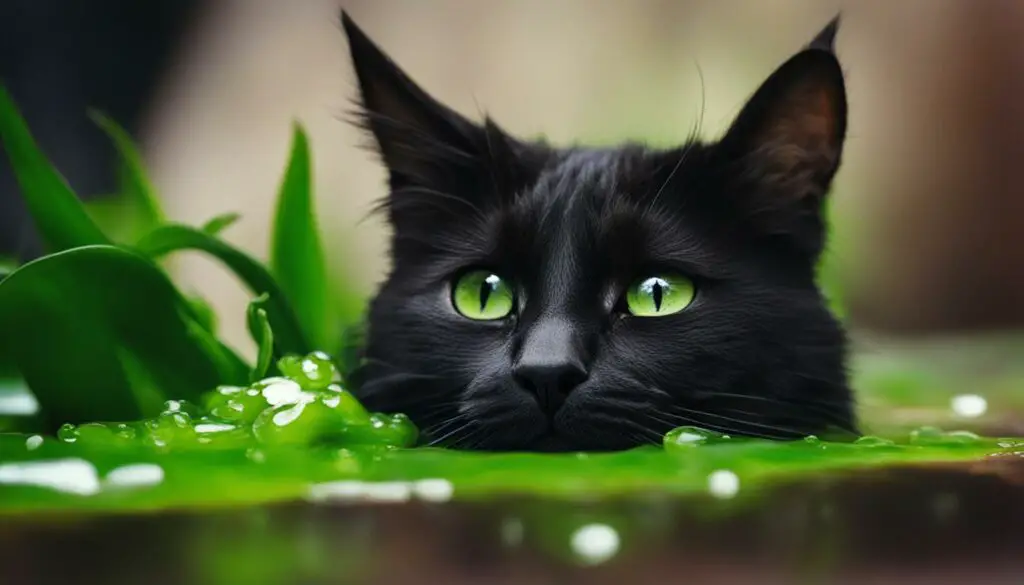
What to Do if Cat Eats Flowers
If you discover that your cat has eaten hyacinth or any other toxic flower, the first step is to contact your veterinarian. They will provide guidance on the appropriate actions to take based on the severity of the situation. It is crucial not to induce vomiting in your cat without professional advice, as it may worsen their condition. Your vet may recommend bringing your cat in for an emergency visit or providing at-home care instructions.
While waiting for veterinary assistance, you can also take some immediate steps to help your cat. Remove any remaining flowers or plant parts from your cat’s mouth, being careful not to get bitten or scratched. If there are visible signs of irritation or discomfort, you can rinse your cat’s mouth with water to help alleviate symptoms.
During this time, it’s essential to monitor your cat closely for any changes in behavior or symptoms. Keep an eye out for vomiting, diarrhea, excessive drooling, or difficulty breathing. If your cat exhibits any severe symptoms or if you are unsure about the appropriate response, it is best to contact an emergency vet for further guidance and immediate care.

Additional Measures to Keep Your Cat Safe
Prevention is key when it comes to protecting your cat from flower-related hazards. Here are some additional measures you can take to keep your feline friend safe:
- Research and familiarize yourself with common toxic flowers and plants. Avoid bringing them into your home or keeping them in areas accessible to your cat.
- If you have flowers or plants that are toxic to cats, consider hanging them from the ceiling or placing them in areas that your cat cannot reach.
- Provide your cat with safe, cat-friendly alternatives. There are many cat-safe flowers available, such as sunflowers, freesias, orchids, snapdragons, and asters. These flowers can add beauty to your home without posing a threat to your cat’s health.
- Regularly inspect your home and garden for any potential hazards, including flowers or plants that may have been brought in by visitors.
By being proactive and taking these measures, you can help ensure that your cat stays safe and healthy, even in the presence of flowers.
| Emergency Action | Key Points to Remember |
|---|---|
| Contact your veterinarian | Seek professional guidance and advice on the appropriate actions to take based on the severity of the situation. |
| Remove any remaining flowers or plant parts from your cat’s mouth | Do this only if you can safely do so without getting bitten or scratched. |
| Rinse your cat’s mouth with water | Help alleviate symptoms of irritation or discomfort, if visible. |
| Monitor your cat for changes in behavior or symptoms | Keep a close eye on your cat for any signs of vomiting, diarrhea, excessive drooling, or difficulty breathing. |
| Contact an emergency vet for further guidance | If your cat exhibits severe symptoms or if you are unsure about the appropriate response, seek immediate veterinary care. |
Emergency Vet for Cats
If your cat has consumed hyacinth and is exhibiting severe symptoms or if you are unsure of the appropriate response, it is best to contact an emergency vet. They are equipped to handle cat health emergencies and can provide immediate care to ensure your cat’s well-being.
The role of an emergency vet is crucial in situations where your cat’s health is at risk. They have the expertise and resources to assess the severity of the ingestion and determine the necessary course of action. Whether it’s administering emergency treatment, conducting diagnostic tests, or providing supportive care, an emergency vet is trained to handle these situations swiftly and effectively.
When you contact an emergency vet for your cat, provide them with a detailed account of the situation, including when the ingestion occurred, the symptoms your cat is experiencing, and any relevant medical history. This information will help the vet make informed decisions about the appropriate treatment plan for your cat.
Remember, time is of the essence when it comes to cat health emergencies. If you suspect your cat has consumed hyacinth or any other toxic substance, do not hesitate to seek immediate veterinary assistance. The quick response can make a significant difference in the outcome of your cat’s health.
Emergency Vet for Cats
| Benefits of Consulting an Emergency Vet | Why an Emergency Vet? |
|---|---|
| Immediate care for your cat | An emergency vet is available 24/7 |
| Expertise in handling cat health emergencies | Specialized equipment and resources |
| Toxicity assessment and treatment | Fast and accurate diagnosis |
| Supportive care options | Quick response time |
By consulting an emergency vet for your cat, you can ensure that they receive the prompt and appropriate care they need in critical situations. It is always better to be safe than sorry when it comes to your cat’s well-being.
Treatment for Hyacinth Poisoning in Cats
If your cat has ingested hyacinth and is experiencing symptoms of poisoning, it is crucial to seek immediate veterinary treatment. The severity of the ingestion and the symptoms exhibited will determine the appropriate course of action. Upon examination, your veterinarian may remove any remaining parts of the plant from your cat’s mouth.
The treatment options for hyacinth poisoning in cats may include inducing vomiting, performing gastric lavage, and administering activated charcoal. Inducing vomiting can help remove the toxins from your cat’s system, but it should only be done under the guidance of a veterinary professional to avoid further complications. Gastric lavage, also known as stomach pumping, may be performed in more severe cases to thoroughly flush out the stomach.
Activated charcoal is often given to cats to help absorb any remaining toxins and prevent them from being further absorbed into the bloodstream. This can be administered orally or via a stomach tube, depending on your cat’s condition and the veterinarian’s recommendation. Other supportive treatments, such as intravenous fluids and medications to manage symptoms, may also be provided to ensure your cat’s comfort and aid in their recovery.
Hyacinth Poisoning Treatment Options:
| Treatment | Description |
|---|---|
| Inducing Vomiting | Under veterinary supervision, vomiting may be induced to remove toxins from the cat’s system. |
| Gastric Lavage | In severe cases, stomach pumping may be performed to thoroughly flush out the stomach. |
| Activated Charcoal | Activated charcoal is given to absorb any remaining toxins in the cat’s system. |
| Supportive Treatments | Intravenous fluids and medications may be provided to manage symptoms and aid in recovery. |
It is important to follow your veterinarian’s instructions and closely monitor your cat during the treatment process. Once treatment has been initiated, your vet will continue to assess your cat’s condition and make any necessary adjustments to ensure their recovery. With prompt veterinary care, cats that have ingested hyacinth can have a good prognosis and make a full recovery.
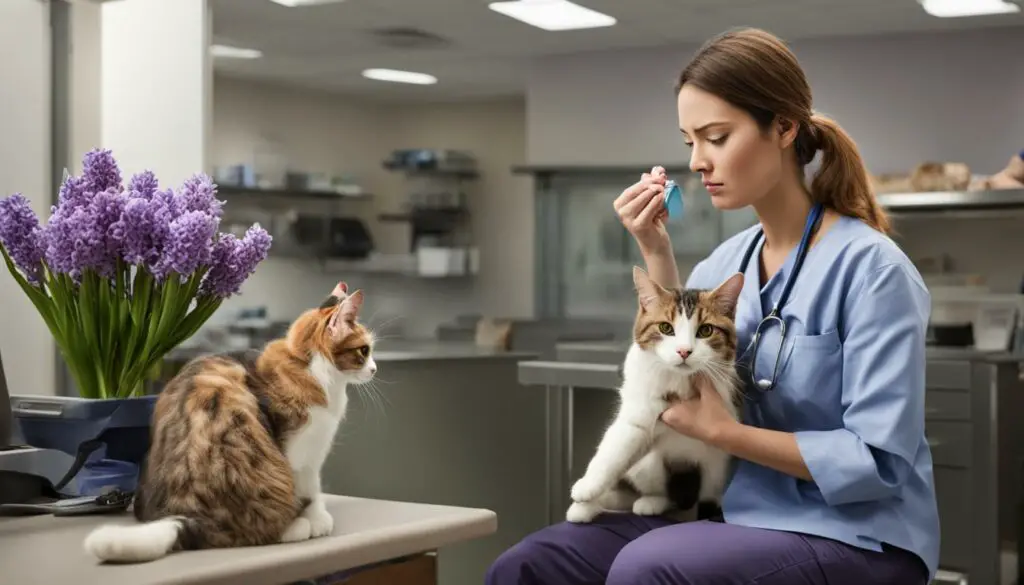
Prognosis for Hyacinth Poisoning in Cats
When it comes to hyacinth poisoning in cats, the prognosis can vary depending on several factors. The amount of hyacinth consumed and the timeliness of treatment play a significant role in determining the outcome. In cases where a small portion of the bulb was ingested and prompt veterinary care was provided, the prognosis is generally favorable, and the cat is likely to make a full recovery.
However, if a large portion of the hyacinth bulb was ingested or if treatment was delayed, the prognosis may be more severe. The toxins present in hyacinths can cause internal and external irritation, leading to various symptoms such as nausea, vomiting, diarrhea, excessive drooling, mouth irritation, increased heart rate, difficulty breathing, and tremors.
If you suspect that your cat has consumed hyacinth or is exhibiting any of these symptoms, it is crucial to contact your veterinarian immediately for guidance and treatment. Prompt action can greatly increase the chances of a positive outcome and minimize the potential long-term effects of hyacinth poisoning in cats.
| Factors Affecting Prognosis for Hyacinth Poisoning in Cats | Prognosis |
|---|---|
| Small portion of bulb consumed | Favorable |
| Large portion of bulb consumed | Severe |
| Prompt treatment provided | Favorable |
| Treatment delayed | Severe |
Remember, prevention is always better than cure. To protect your cat from hyacinth poisoning, it is essential to eliminate these plants from your home and property. If you choose to have hyacinths or other potentially toxic flowers, make sure they are placed in areas that are inaccessible to your cat. Hanging the flowers from the ceiling or using planters that your cat cannot reach can help minimize the risk.
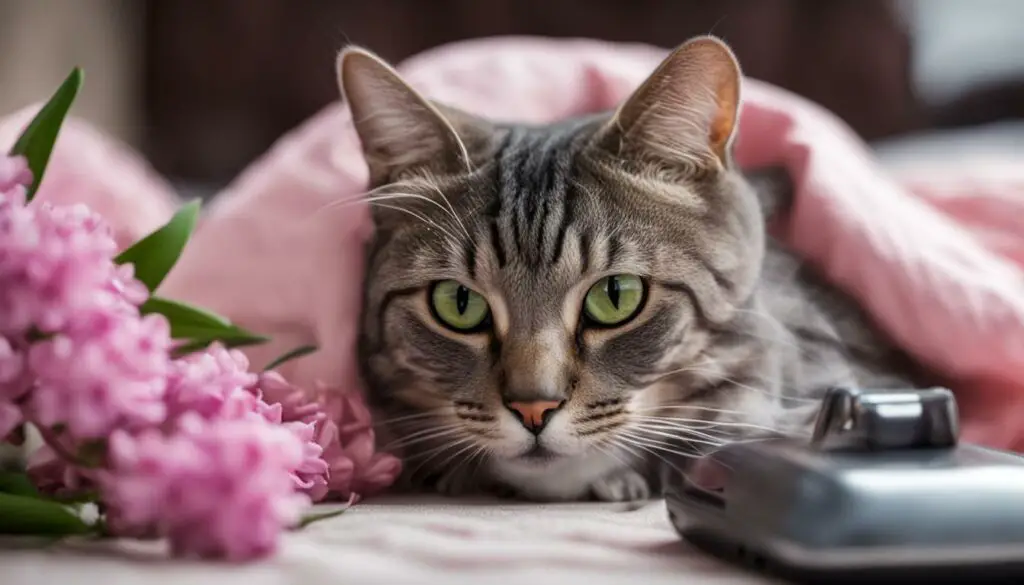
By being aware of the plants that are toxic to cats and taking precautions to keep them out of their reach, you can create a safe environment for your feline friend. If you want to enjoy the beauty of flowers without risking your cat’s health, there are many cat-safe alternatives available such as sunflowers, freesias, orchids, snapdragons, and asters. These flowers can add color and fragrance to your home or garden without posing a threat to your furry companion.
Preventing Hyacinth Poisoning in Cats
Preventing hyacinth poisoning in cats is crucial to keeping them safe from potential health emergencies. By taking a few simple precautions, you can minimize the risk of your feline friend coming into contact with this toxic plant.
1. Remove the plant: The best way to prevent hyacinth poisoning is to eliminate the plant from your home and property. If you have hyacinths or other toxic flowers, consider removing them altogether.
2. Keep flowers out of reach: If you choose to keep hyacinths or other potentially dangerous flowers, make sure they are placed in areas that are inaccessible to your cat. You can hang flowers from the ceiling or use planters that are out of your cat’s reach.
3. Be aware of toxic plants: It’s important to familiarize yourself with plants that are toxic to cats. Hyacinths are just one example, but there are many other common plants that can pose a threat to your cat’s health. Research and ensure you are aware of the plants to avoid.
“Preventing hyacinth poisoning in cats is crucial to keeping them safe from potential health emergencies.”
Hyacinth Poisoning Prevention Tips:
- Research and identify toxic plants
- Remove toxic plants from your home
- Place flowers out of your cat’s reach
- Consider cat-safe alternatives for a beautiful home or garden
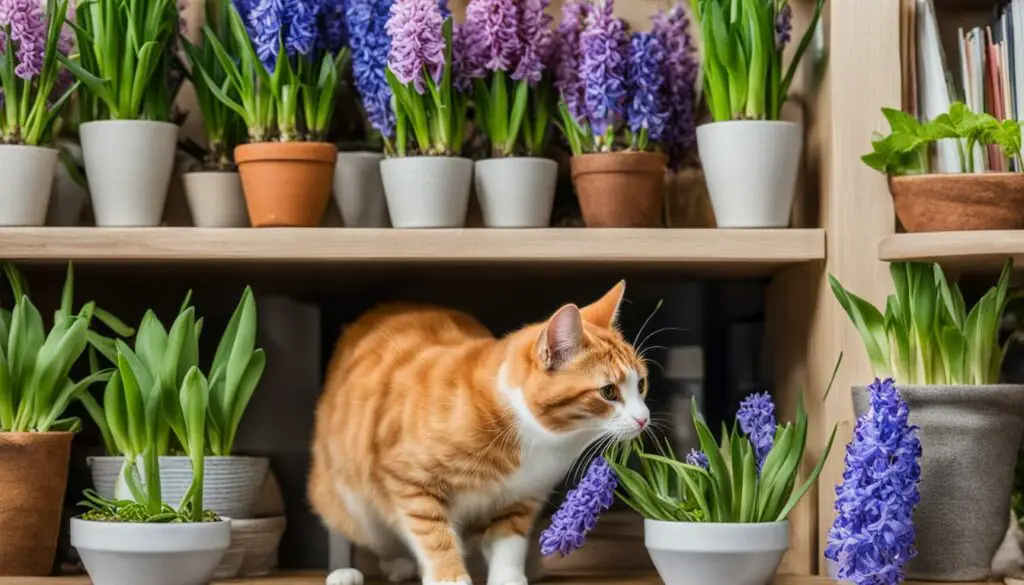
| Plant | Toxicity |
|---|---|
| Hyacinth | Highly toxic |
| Sunflower | Non-toxic |
| Freesia | Non-toxic |
| Orchid | Non-toxic |
By following these preventative measures, you can help protect your cat from the dangers of hyacinth poisoning and create a safe environment for them to thrive in.
Alternatives Flowers That Are Safe for Your Cat
When it comes to enjoying the beauty of flowers while keeping your feline friend safe, there are plenty of cat-safe options available. Consider incorporating the following flowers into your home or garden:
- Sunflowers: These vibrant flowers are not only visually striking but also safe for cats to be around.
- Freesias: Freesias produce beautiful and fragrant blooms that are safe for your cat to enjoy.
- Orchids: Known for their elegance, orchids are non-toxic to cats and can add a touch of sophistication to any space.
- Snapdragons: These unique flowers come in a variety of colors and are a safe choice for cat owners.
- Asters: These daisy-like flowers are a popular choice for gardens and are completely safe for cats.
By opting for these cat-safe flowers, you can create a beautiful and pet-friendly environment without worrying about potential harm to your furry companion. Whether you choose to grow them indoors or outdoors, these flowers will add color, fragrance, and a touch of nature to your surroundings.

Remember, it’s always important to be aware of the plants that are toxic to cats and take necessary precautions to keep them out of your cat’s reach. By eliminating the risk of toxic flowers and incorporating cat-safe alternatives, you can enjoy the beauty of nature while keeping your furry friend safe and happy.
Conclusion
Having a cat that has ingested hyacinth flowers can be a cause for concern and may lead to serious health issues. If you notice your cat vomiting, experiencing diarrhea, or showing signs of poisoning after eating flowers, it is important to take immediate action.
Contacting your veterinarian right away is crucial in these situations, as they can provide the necessary guidance and treatment to ensure your cat’s well-being. It is important not to induce vomiting without professional advice, as it can worsen their condition.
To prevent such emergencies, it is best to keep potentially toxic plants, like hyacinths, out of your cat’s reach. If you want to enjoy beautiful flowers without risking your cat’s health, consider cat-safe options like sunflowers, freesias, orchids, snapdragons, and asters. By being proactive and aware of the plants that can be harmful to your feline friend, you can create a safe environment for them to thrive in.
FAQ
Are hyacinth flowers toxic to cats?
Yes, hyacinth flowers, especially the bulbs, are toxic to cats. The toxins present in hyacinth bulbs can cause internal and external irritation, leading to various symptoms and health issues in cats.
What are the symptoms of hyacinth poisoning in cats?
Symptoms of hyacinth poisoning in cats may include nausea, vomiting, diarrhea, excessive drooling, mouth irritation, depression, increased heart rate, difficulty breathing, and tremors.
What should I do if my cat eats hyacinth flowers?
If your cat eats hyacinth flowers, it is important to contact your veterinarian immediately for guidance and treatment. They will provide instructions based on the severity of the situation.
Should I induce vomiting in my cat if they have eaten hyacinth?
It is crucial not to induce vomiting in your cat without professional advice, as it may worsen their condition. Contact your veterinarian for the appropriate course of action.
When should I contact an emergency vet for my cat?
If your cat has consumed hyacinth and is exhibiting severe symptoms or if you are unsure of the appropriate response, it is best to contact an emergency vet. They can provide immediate care and guidance.
How is hyacinth poisoning in cats treated?
The treatment for hyacinth poisoning in cats depends on the severity of the ingestion and symptoms exhibited. It may include inducing vomiting, gastric lavage, and the administration of activated charcoal.
What is the prognosis for cats that have ingested hyacinth?
The prognosis for cats that have ingested hyacinth depends on the amount consumed and the timeliness of treatment. Prompt treatment increases the chances of a full recovery.
How can I prevent hyacinth poisoning in cats?
The best way to prevent hyacinth poisoning in cats is to eliminate the plant from your home and property. If you choose to have potentially toxic flowers, ensure they are placed in areas that are inaccessible to your cat.
Are there any flower alternatives that are safe for cats?
Yes, there are many cat-safe flowers available, such as sunflowers, freesias, orchids, snapdragons, and asters. These flowers can add beauty to your home or garden without posing a threat to your cat.
Source Links
- https://wagwalking.com/cat/condition/hyacinth-poisoning-1
- https://ourfitpets.com/health/digestive-system/my-cat-ate-hyacinths-what-should-i-do/
- https://www.hepper.com/are-hyacinths-poisonous-to-cats/

